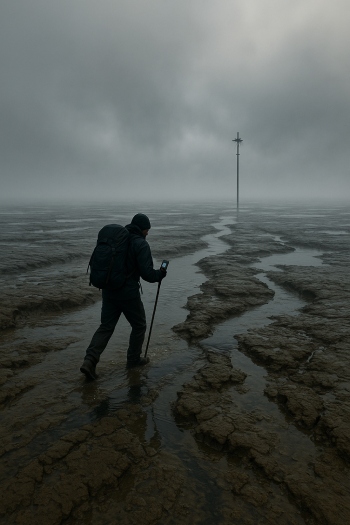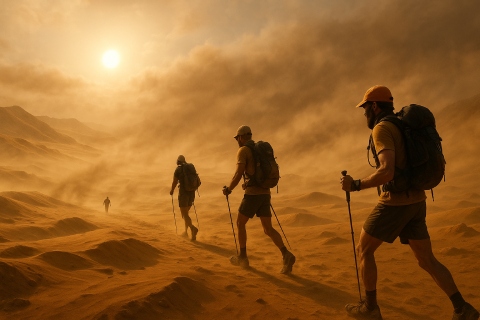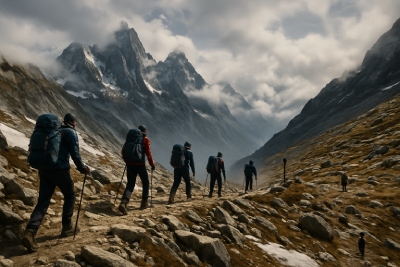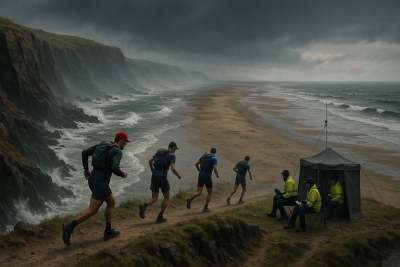The Danger of the Broomway

Multiple hazards render Broomway uniquely perilous and can hence attribute the some-name hazardous reputation to it. The ancient tidal track has been testing those who dared to venture for centuries by pitting natural obstacles and unpredictable conditions against isolation-making for one of the most deadly combinations of different aspects ever known on a landscape.
Environmental Hazards
The Broomway sands and mudflats appear hard but conceal areas of gooey pits, deep water channels, and shifting grounds that might just devour a human with a snap. The current tides are ranked among the fastest in the world, finishing off travelers in mere minutes. Watchfully judging the current is necessary for any walker; indeed, this becomes their constant occupation in disengaging themselves from being victims of such enveloping tide. Fogs arise from the North Sea time and again. They reduce visibility to next to nothing and somehow within a matter of minutes, one can stray completely from the path. From that point, without the either original broom markers or a GPS device, the very pathway itself can turn into a disorienting maze.
Thusly, a dynamic nature compounds the danger of the mudflats. With the shifting through time of the channels, what was once a safe passage might be rendered treacherous. A tiny misstep might land a victim in deep mud, a sudden hole, or water channels, and the combination of fog, tide, and quicksand has accounted for many tragic deaths in history. These travelers are caught between a faraway view that seems calm and empty while, in actuality, is most unpredictable and forever undergoing change.
Isolation and Risk
Another menace posed by the Broomway is that of isolation. The way lies far away from towns and medical facilities, while its remoteness can make rescue efforts very slow if not outright impossible. There are no checkpoints or marshals or emergency teams to intervene in these areas. Thus, by the time someone realizes there is an emergency, rescue attempts would either be too late or delayed for a couple of hours.
Crossing successfully requires precise timing and acute premonition of environmental cues. Travelers must consider tide timetables, weather changes, and visibility while at the same time negotiating shifting mud and hidden channels. One minute of wrong judgment, one minute too late, or one minute distracted may get the Broomway to trap. This interlacing of hazards has taught the path humility, survival, and respect for nature; hence, rebuking anyone that nature considers overconfident or inexperienced.
The Appeal of Extreme Natural Challenges

Whether this human fascination for extreme conditions is at the heart of folklore or survival stories is debatable. All around the world, athletes expose themselves to physically and mentally demanding environments where natural dangers are turned into sports. Common to these extreme activities is testing the limits of nature, where preparation, endurance, and resilience are considered necessary skills to outlast it. Putting risk into controlled settings turns it into a challenge to be measured, trained for, and rejoiced, while uncontrolled perils like those on the Broomway remain out of measure.
Being among the most extraordinary and severe challenges, desert ultramarathons attract their own set of competitors. Traditional events such as the Marathon des Sables, touted as the "world's toughest footrace," take runners over hundreds of kilometers of arid terrain. Scorching temperatures, sandstorms, and the relentless sun harassment offer the company, sun with whom the race rivals in the threat of extinction, albeit runners sometimes carry their own supplies. Much like the Broomway, the stages test individuals with environmental challenges demanding careful strategizing, training, and sheer mental fortitude-cum-determination. Yet unlike a blind crossing of tidal flats in complete risk, there are medical teams, clearly marked routes, and emergency procedures in place along all ultramarathon routes, all of which serve to reduce the risk albeit barely counterbalance the factor of challenge.
Mountain Treks: Altitude and Endurance

High-altitude trekking is one more avenue of extreme adventure in the Alps, the Himalayas, or the Andes. Mountain treks traverse difficult terrain, including sporadic weather variations and altitude sickness. Hikers have to carefully monitor their pace, hydration, and energy levels if they are to survive and complete the trek. While the stakes are serious, they are subdued by established routes, guiding services, and safety aids, making it a relatively structured way of braving nature's harshest conditions. In many aspects, the psychological stress required has quite a lot in common with anyone who attempts to cross the Broomway-called by virtue of always having to be alert, paying unrelenting attention to ever-changing conditions, and unpredictable nature of the environment.
While mountain hikes pose both challenges and rewards, this is somewhat another difference. Whereas the tidal walk can boast of ominous beauty and ancient mystery, the ground is inherently dangerous. Structured treks in the great outdoors offer an opportunity to feel the exhilarating exposure to natural elements, yet safety precautions ensure that participants' attempts to push the envelope do not come at the potential cost of life.
Coastal Ultra-Trails: Combining Terrain and Tides

This phrase represents, in a way, an interface between the desert and mountain landscapes, on the one hand, and tidal hazards on the other. Long-distance runs are classic examples of coastal activities that take place on cliffs and beaches and even some parts of tidal zones, exposing runners to what was essentially a dramatic change in weather conditions accelerated by wind waves. Runs like the Ultra-Trail Côte d'Azur or the West Highland Way test athletes in mixed terrains through fatigue and weather hazards. The presence of officials and checkpoints with communication systems ensure that risk is part of the sport and, yet, does not ever attain the status of deathly hazards.
The awareness of tidal behavior is a significant commonality they share with the Broomway. The coastal ultra-trails educate runners about respecting tides and natural timing, which is equally needed when crossing Essex’s skin-deep perilous flats. Yet the organized nature of these events allows participants to contend with similar natural hazards without the high-stakes, life-or-death consequence that has traditionally marked the Broomway.
Lessons from the Broomway in Extreme Sports
Studying the Broomway and its dangers reveals much about the attractiveness of extreme sports. Both sports call for confronting natural challenges that demand dignity, prerequisites, and conditioning. Ultramarathoners, mountain trekkers, or those running ultra-trails along the coast undergo a microcosmic effect of the tension between human will and environmental randomness. The contrast is structure: contemporary extreme sports come with rules, safety policies, and emergency responses which totally measure and assess the challenge rather than rendering it a potential one-way ticket to the grave.
To an enthusiast, the Broomway stands as a supreme caution. It embodies the raw, untamed danger of nature without a single human safeguard. Organized extreme sports, on the other hand, afford athletes the training for endurance, tactics, and mental fortitude while offering a margin of safety. This contrast sets forth the thin line on a scale between thrill and danger, preparedness and improvisation, Nature's might and human genius.
Understanding Risk & Respecting Nature
Whether it is making the crossing of a tidal highway like the Broomway or competing in an endurance race, knowing about risk is paramount. The knowledge, experience, and the humility one brings to bear on nature can mean success or disaster. Some extreme sportspeople speak of mastery, personal development, and enhanced environmental consciousness as their rewards. Opposite to these is the Broomway, which teaches an important cautionary lesson: misjudgment here can cost lives, and nature will never forgive when neither structure nor support exists.
This comparison also highlights the desire for adventure in humans. Since the early days, over perilous roads and more recent ultra marathon events, humans have been confronted with challenges that test their physical and mental capacities. The difference is not in courage but in preparation and circumstances. While with the Broomway, error is impossible, extreme sport events provide an opportunity where danger becomes a game for testing skill, endurance, and strategy under more or less controlled conditions.
Danger and Thrill in the Great Outdoors
More than being merely a tidal path, the Broomway can be regarded as a testimony to nature's merciless power. Quick tides, fog, and ever-shifting sands make it deadly for those who are not prepared.Mountain trekking, desert ultramarathons, and coastal ultra-trails-orchestrated sports are somewhat the same: encounters with natural extremes, but with structure, planning, and safety measures. Drawing the Broomway into a discourse with these sports emphasizes therefore the need for preparation when confronting nature, but also awareness and respect for the elements. The Broomway is still a lesson in survival while extreme sports provide a safe means to test human limits.